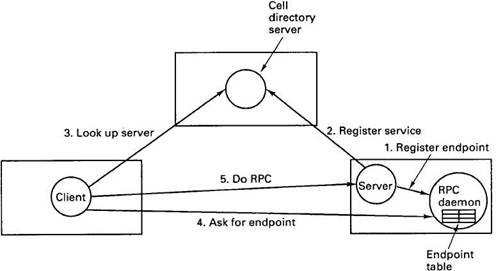Книга: Distributed operating systems
10.3.3. Binding a Client to a Server
10.3.3. Binding a Client to a Server
Before a client can call a server, it has to locate the server and bind to it. Naive users can ignore the binding process and let the stubs take care of it automatically, but binding happens nevertheless. Sophisticated users can control it in detail, for example, to select a specific server in a particular distant cell. In this section we will describe how binding works in DCE.
The main problem in binding is how the client locates the correct server. In theory, broadcasting a message containing the unique identifier to every process in every cell and asking all servers for it to please raise their hands might work (security considerations aside), but this approach is so slow and wasteful that it is not practical. Besides, not all networks support broadcasting.
Instead, server location is done in two steps:
1. Locate the server's machine.
2. Locate the correct process on that machine.
Different mechanisms are used for each of these steps. The need to locate the server's machine is obvious, but the problem with locating the server once the machine is known is more subtle. Basically, what it comes down to is that for a client to communicate reliably and securely with a server, a network connection is generally required. Such a connection needs an endpoint, a numerical address on the server's machine to which network connections can be attached and messages sent. Having the server choose a permanent numerical address is risky, since another server on the same machine might accidentally choose the same one. For this reason, endpoints can be dynamically assigned, and a database of (server, endpoint) entries is maintained on each server machine by a process called the RPC daemon, as described below.
The steps involved in binding are shown in Fig. 10-14. Before it becomes available for incoming requests, the server must ask the operating system for an endpoint. It then registers this endpoint with the RPC daemon. The RPC daemon records this information (including which protocols the server speaks) in the endpoint table for future use. The server also registers with some cell directory server, passing it the number of its host.

Fig. 10-14. Client-to-server binding in DCE.
Now let us look at the client side. In the simplest case, at the time of the first RPC, the client stub asks the cell directory server to find it a host running an instance of the server. The client then goes to the RPC daemon, which has a well-known endpoint, and asks it to look up the endpoint (e.g., TCP port) in its endpoint table. Armed with this information, the RPC can now take place. On subsequent RPCs this lookup is not needed. DCE also gives clients the ability to do more sophisticated searches for a suitable server when that is needed. Authenticated RPC is also an option. We will discuss authentication and protection later in this chapter.
- 2.4.3. Dynamic Binding
- 10.3. REMOTE PROCEDURE CALL
- 10.3.4. Performing an RPC
- The ABCs of WCF
- Configuring DHCP servers
- Creating Self- Hosted WCF Service
- Тестирование Web-сервиса XML с помощью WebDev.WebServer.exe
- InterBase Super Server для Windows
- Каталог BIN в SuperServer
- Минимальный состав сервера InterBase SuperServer
- InterBase Classic Server под Linux
- Каталог BIN в InterBase Classic Server для Linux




